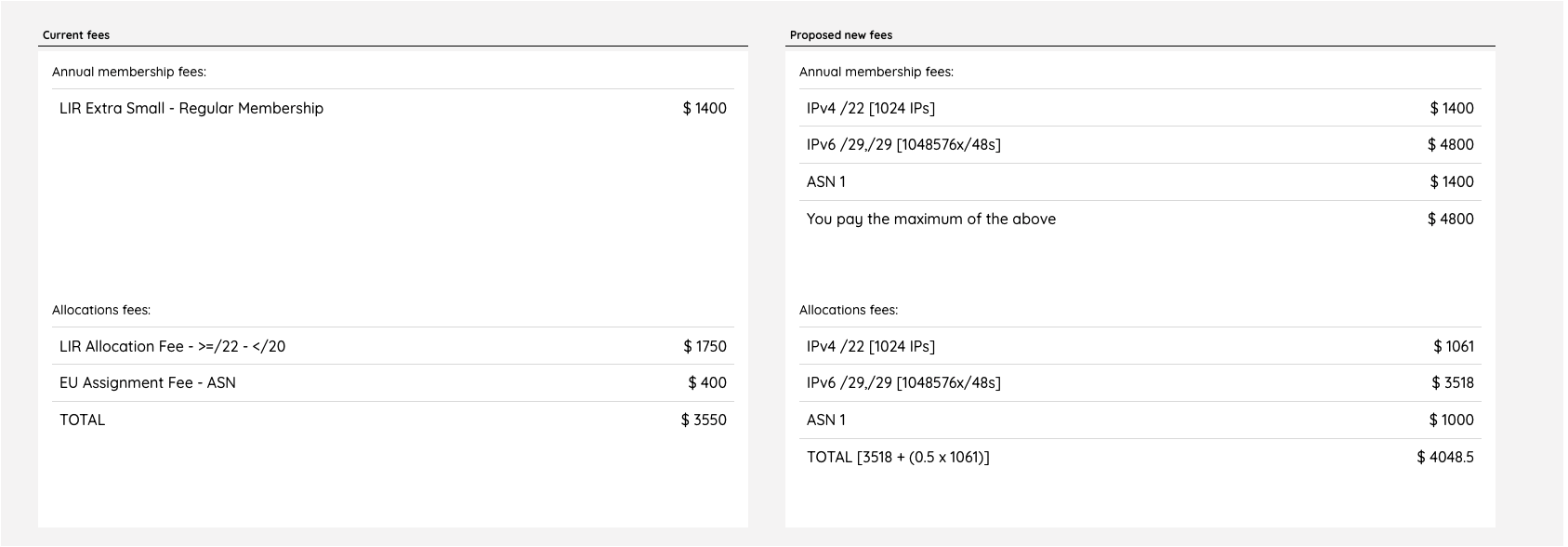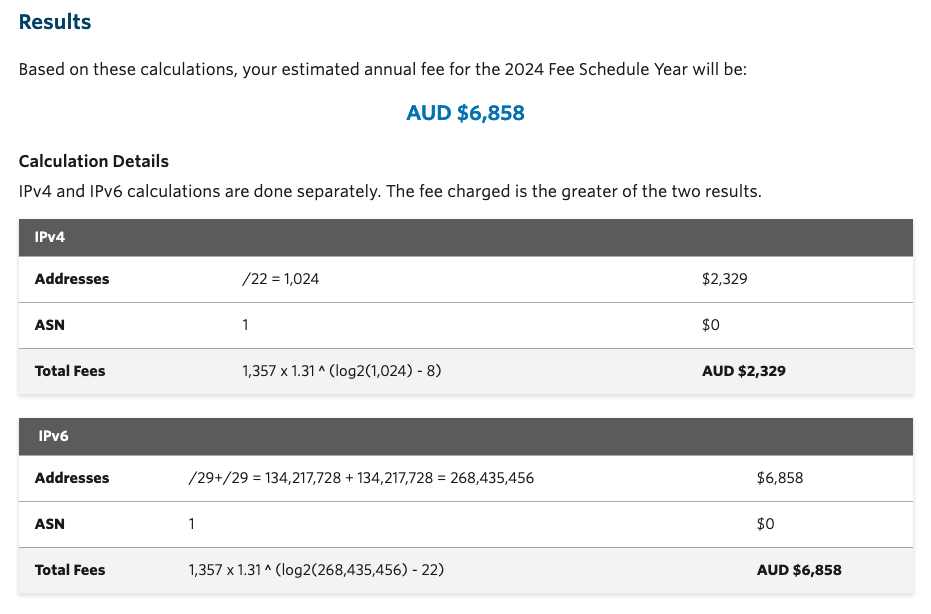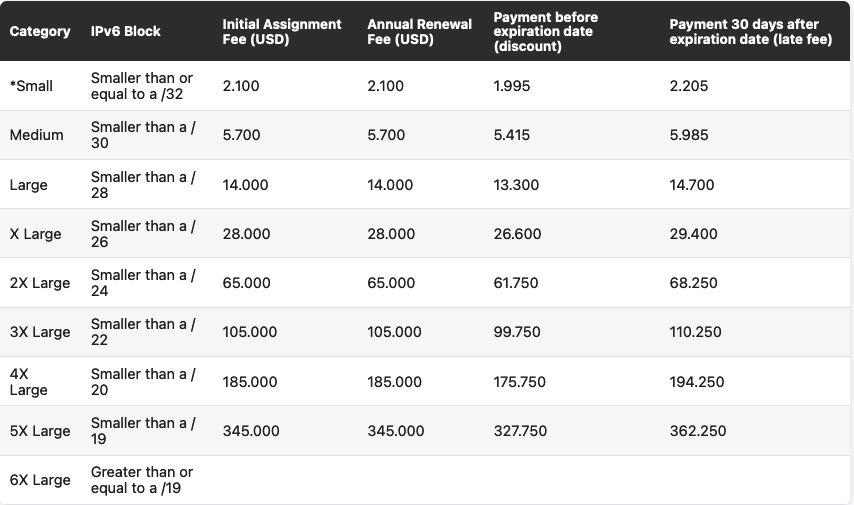Membership costs in other RIRs. What would I pay somewhere else ?
During the upcoming RIPE88 Meeting in Krakow, there will be a RIPE NCC General Meeting, and a vote about the charging scheme for 2025 will be held.
The RIPE NCC has provided us with the options for voting, as set by the board. They are three, as follows:
-
Option A - Charging Scheme as is with 22.58% price increase for the annual contribution per LIR account (EUR 1,900) and a 0% price increase for Independent Internet number resource assignments* (EUR 50)
-
Option B - Charging Scheme as is with 20.97% price increase for the annual contribution per LIR account (EUR 1,875) and a 50% price increase for Independent Internet number resource assignments* (EUR 75)
-
Option C - Charging Scheme as is with 16.13% price increase for the annual contribution per LIR account (EUR 1,800), a 50% price increase for Independent Internet number resource assignments* (EUR 75) and a new AS Numbers fee of EUR 50 per assignment
This proposal has created a lot of discussions on both the RIPE Community Telegram Group and on the members-discuss mailing list.
On the ITNOG Telegram Group there were claims that RIPE NCC was the most expensive RIR to be a member of. This led me to start looking at what costs I would need to consider for my LIR if I ever wish to move it elsewhere.
My LIR has the following resources:
- An ASN (AS58280, of course);
- A /22 IPv4 (45.129.224.0/22);
- Two /29 IPv6 (2a0e:5040::/29 and 2a0f:fd00::/29). The first one came as a direct allocation, while the second one came as a transfer, and has been used for research purposes for the last couple of years.
I have decided to check how much I would pay, with the same amount of resources, in other RIRs.
Just to set the tone, for RIPE NCC, my membership fees were 1550 euro plus VAT, so in total 1810.28 euro, as taken from my credit card statement.
AfriNIC
I headed to the AfriNIC fee calculator - https://afrinic.net/fee-calculator-nf, and filled it in as in the picture:


The total cost with current fees would be 3550 $. At first glance, this is around twice as much as the RIPE NCC fees, but there are only 1400 $ of recurring fees, while 2150 $ are for the "setup" and are non-recurring. I have asked on the ZANOG Discuss Telegram Group for more information about the proposed new fees, and was told that the initiative stalled when AfriNIC started having the issues we all know about.
APNIC
APNIC has a fee scheme where you pay based on the resources you hold. I went to the calculator for fees for Non-Members (https://www.apnic.net/get-ip/apnic-membership/how-much-does-it-cost/non-member-fees-calculator/), and filled it in as follows:

Which returned the following result:

There are some additional explanations:
If the resources specified above were held under a Member account, the base fee would be AUD $5,964, instead of AUD $6,858, yielding a saving of AUD $894.
IPv4 and IPv6 calculations are done separately. The fee charged is the greater of the two results.
Your Non-Member account renewal invoices will be calculated based on your resource holdings assessed as at the date of your Non-Member account anniversary.
- Only applies to APNIC Non-Members
- Estimated fees are based on the higher of IPv4 or IPv6 fees
- Address holdings include current and historical resources
- These estimates exclude Good and Services or consumption tax. This tax varies according to the Non-Member's economy and whether the organization is registered to pay such tax
- Based on the 2024 Fee Schedule
Which means I would need to pay 6858 Australian Dollars, which amount roughly to 4458.39 $ on the day of writing.
If I were to become a member, I would pay 5964 Australian Dollars, about 3876.24 $.
As I said initially, my LIR could be a bit of an outlier, in the sense that the second /29 IPv6 allocation is not a normal condition. Without it, the costs would go down to 4552 Australian dollars (2961.12$) or 5235 Australian Dollars (3405.42$), wether I would decide to be a member or not.
ARIN
ARIN has a category-based model, which you can find at https://www.arin.net/resources/fees/fee_schedule/:

In my case, my LIR would fall into the "Small" category, mostly due to the IPv6 allocations, which amount to a /28. This would mean 2000 $ of recurring fees.
LACNIC
LACNIC is also based on categories, and you pay the highest amount between IPv4 and IPv6 and the category you end up in.
For IPv4 the categories are the following (from https://www.lacnic.net/5448/2/lacnic/):

There are more, bigger categories, but they are out of scope of this article.
As you can see, my LIR would fall into the Micro Category, which would have a renewal fee of 1000$, or 950$ if paid before the expiration date.
Looking at IPv6, we have the following categories (from https://www.lacnic.net/5450/2/lacnic/isp-ipv6-fees):

With 2x /29 - which account for a /28, my LIR would fall under the X Large category, which would mean having to pay 28000$, or 26600$ if paid before expiration date. As in the case of APNIC, my LIR is an outlier, but even with just a single /29 - which is the "most normal" allocation from the RIPE NCC, we would still be looking at 14000$, or 13300$ discounted.
Luckily, there is no fee for ASNs.
All in all, I would be billed 28000$, which is about 14 times what I pay at the RIPE NCC for the same amount of resources.
Summary
Here is a breakdown of what I would pay in all the RIRs, in a simple table. Everything in USD:
| RIR | IPv4 | IPv6 | ASN | Payable Fee |
|---|---|---|---|---|
| AfriNIC | - | - | - | 1.400,00 |
| APNIC | 1.515,04 | 4.458,39 | - | 4.458,39 |
| ARIN | 1.000 (X-Small) | 2.000 (Small) | - | 2.000,00 |
| LACNIC | 1.000 (Micro) | 28.000 (X-Large) | - | 28.000,00 |
| RIPE NCC | - | - | - | 1.657,11 |
For a better comparison, let's check what it would look like without the additional /29. Amounts are in USD:
| RIR | IPv4 | IPv6 | ASN | Payable Fee |
|---|---|---|---|---|
| AfriNIC | - | - | - | 1.400,00 |
| APNIC | 1.515,04 | 2.961,12 | - | 2.961,12 |
| ARIN | 1.000 (X-Small) | 2.000 (Small) | - | 2.000,00 |
| LACNIC | 1.000 (Micro) | 14.000 (X-Large) | - | 14.000,00 |
| RIPE NCC | - | - | - | 1.657,11 |
The two changes would be at APNIC and LACNIC, where LACNIC would see a 50% reduction in costs. Still, we are talking of almost 10x what I am actually paying at the RIPE NCC.
RIPE NCC scores as the second cheapest RIR to hold resources similar to what my LIR has. It is a simple fee that does not need any calculations. If the majority of voters were to choose option A, increasing fees to 1900 eur, that would bring RIPE NCC slightly above ARIN with actual exchange rate, at 2031.29$. With options B and C, it would still be below ARIN, albeit very close.
My LIR is a personal project, tied of course with AS58280, so of course I'm not particularly happy about increases in fees, but there are reasons for doing it at the moment. I will be participating in the BoF about building a stable future for the RIPE NCC at the upcoming RIPE88 meeting in Krakow, and I hope many other people will do as well, with the intent of creating a good discussion on how to keep the RIPE NCC running in these challenging times.